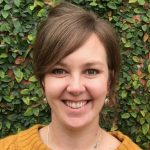By ANNA MARIE BEAUCHEMIN
Special to the Gazette
When I was growing up, my mom had a plethora of remedies that she would use with me whenever I got sick. She had a kitchen cabinet full of herbs and spices, and a pantry full of food that she somehow seemed to magically weave together, into something that usually left me feeling better than I did before. She was my go-to practitioner for most of my life. No matter what the ailment was (granted, I have been fortunate with good health in my 33-years on this earth), she always seemed to have something up her sleeve that would help. We had a garden in the backyard that provided us with homegrown fruits and vegetables, and chickens in the coop that gave us fresh eggs. We were surrounded by the natural beauty and plants of the Alhambra Valley.

The roots of our country’s medicine are not so different from the tale I told above. From the family caregiver, to the community doctor, to the indigenous healers that came before us, the roots of medicine in the United States, and the rest of the world are based on very similar principles – using the plants and foods around you to heal that which ails you.
In California, there are a lot (and I mean a lot) of plants that grow here and that are extremely beneficial to our health and well-being. From the weeds that grow in our backyards, to the majestic Bay Laurel trees in the Carquinez hills, we are surrounded by plants with medicinal properties. The therapeutic use of these plants is called herbal medicine.
With a 5000-year history of being used by people around the world, [1] the practice of using plants as medicine is a long-standing tradition across the globe. Flash forward to the present day, and the field of herbalism continues to grow and change to meet the needs of the modern person. In addition to a rich oral and written history supported by anecdotal evidence, herbal medicine is now studied at the clinical level as well. Due to the advancements in modern science, we can now pick a plant apart, isolate the exact phytochemicals within that plant that lead to its healing properties, and look at how those properties affect a person’s physiology and health.
We are fortunate in the United States to have a well-established modern medicine system which saves countless lives on a daily basis. Advancements in western medicine have allowed people to live longer – an opportunity that was not always available in previous times. Contemporary medicine is an incredible thing, and I think because of this many people assume that the choice is one or the other; do I go the natural route, or do I go the doctor instead?
Luckily, living in this world right now, we have the option to choose both. We can utilize the traditions of those who came before us while simultaneously benefiting from the innovations of modern medicine. When used as a compliment to your regular healthcare practice, these two approaches to wellness have a tremendous opportunity to heal.
Why herbs? Because that’s what people have been doing since the beginning of time, and lucky for us, they’re everywhere!
Note: For more information about local, seasonal, herbal remedies and regional botanical information, check back on the first Sunday of every month. Want to learn more and can’t wait? I will be teaching a free workshop on Herbalism at Harvest House in Concord on April 15th from 11:00-12:00.
Anna Marie Beauchemin is a trained Clinical Western Herbalist and Biologist. Born and raised in Martinez, California, she is passionate about sharing her craft with her community and helping people to find balance and wellness in their lives. She runs her practice in downtown Martinez – offering herbal consultations and custom formulations, herbal education, product development and consulting, and community herb walks. For more information about her services contact her at eastbayherbals@gmail.com.
[1] Herbal Medicine Fundamentals. (2016, November 13). Retrieved March 24, 2018, from https://www.americanherbalistsguild.com/herbal-medicine-fundamentals






2 Replies to “The Hometown Herbalist: Why Herbs?”